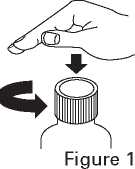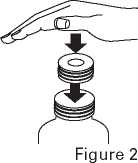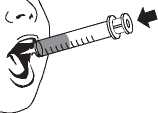Pregabalin Teva 20 Mg/Ml Oral Solution
Package leaflet: Information for the user
Read all of this leaflet carefully before you start taking this medicine because it contains important information for you.
• Keep this leaflet. You may need to read it again.
• If you have any further questions, ask your doctor or pharmacist.
• This medicine has been prescribed for you only. Do not pass it on to others. It may harm them, even if their signs of illness are the same as yours.
• If you get any side effects, talk to your doctor or pharmacist. This includes any possible side effects not listed in this leaflet. See Section 4.
What is in this leaflet:
1. What Pregabalin Teva is and what it is used for
2. What you need to know before you take Pregabalin Teva
3. How to take Pregabalin Teva
4. Possible side effects
5. How to store Pregabalin Teva
6. Contents of the pack and other information
OH What Pregabalin Teva is and what it is used for
Pregabalin Teva belongs to a group of medicines used to treat epilepsy and Generalised Anxiety Disorder (GAD) in adults.
Epilepsy: Pregabalin Teva is used to treat a certain form of epilepsy (partial seizures with or without secondary generalisation -epileptic fits starting on one specific part of the brain) in adults. Your doctor will prescribe Pregabalin Teva for you to help treat your epilepsy when your current treatment is not controlling your condition. You should take Pregabalin Teva in addition to your current treatment. Pregabalin Teva is not intended to be used alone but should always be used in combination with other anti-epileptic treatment.
Generalised Anxiety Disorder: Pregabalin Teva is used to treat Generalised Anxiety Disorder (GAD). The symptoms of GAD are prolonged excessive anxiety and worry that are difficult to control. GAD can also cause restlessness or feeling keyed up or on edge, being easily fatigued (tired), having difficulty concentrating or mind going blank, feeling irritable, having muscle tension or sleep disturbance. This is different to the stresses and strains of everyday life.
Pregabalin which is contained in Pregabalin Teva is also authorised to treat other conditions which are not mentioned in this leaflet. Ask your doctor or pharmacist if you have further questions.
©H What you need to know before you take Pregabalin Teva
Do not take Pregabalin Teva:
• if you are allergic to pregabalin or any of the other ingredients of this medicine (listed in section 6).
Warnings and precautions
• Some patients taking pregabalin have reported symptoms suggesting an allergic reaction. These symptoms include swelling of the face, lips, tongue, and throat, as well as diffuse skin rash. Should you experience any of these reactions, you should contact your physician immediately.
• Pregabalin has been associated with dizziness and somnolence, which could increase the occurrence of accidental injury (falls) in elderly patients. Therefore, you should be careful until you are used to any effect the medicine might have.
• Pregabalin Teva may cause blurring or loss of vision, or other changes in eyesight, many of which are temporary. You should immediately tell your doctor if you experience any changes in your vision.
• Some patients with diabetes who gain weight while taking pregabalin may need an alteration in their diabetic medicines.
• There have been reports of heart failure in some patients when taking pregabalin; these patients were mostly elderly with cardiovascular conditions. Before taking this medicine you should tell your doctor if you have a history of heart disease.
• There have been reports of kidney failure in some patients when taking pregabalin. If while taking Pregabalin Teva you notice decreased urination, you should tell your doctor as stopping the medicine may improve this.
• A small number of people being treated with anti-epileptics such as Pregabalin Teva have had thoughts of harming or killing themselves. If at any time you have these thoughts, immediately contact your doctor.
• When Pregabalin Teva is taken with other medicines that may cause constipation (such as some types of pain medicines) it is possible that gastrointestinal problems may occur (e.g. constipation, blocked or paralysed bowel). Tell your doctor if you experience constipation, especially if you are prone to this problem.
• Before taking this medicine you should tell your doctor if you have a history of alcoholism or drug dependence. Let your doctor know if you think you need more medicine than prescribed.
• There have been reports of convulsions when taking pregabalin or shortly after stopping pregabalin. If you experience a convulsion, contact your doctor immediately. • There have been reports of reduction in brain function (encephalopathy) in some patients taking pregabalin when they have other conditions. Tell your doctor if you have a history of any serious medical conditions, including liver or kidney disease.
Children and adolescents
The safety and efficacy in children and adolescents (under 18 years of age) has not been established and therefore, pregabalin should NOT be used in this age group.
Other medicines and Pregabalin Teva
Tell your doctor or pharmacist if you are taking, have recently taken or might take any other medicines.
Pregabalin Teva and certain other medicines may influence each other (interaction). When taken with certain other medicines, Pregabalin Teva may potentiate the side effects seen with these medicines, including respiratory failure and coma. The degree of dizziness, sleepiness and decreased concentration may be increased if Pregabalin Teva is taken together with medicinal products containing:
• Oxycodone - (used as a pain-killer)
• Lorazepam - (used for treating anxiety)
• Alcohol.
Pregabalin Teva may be taken with oral contraceptives.
Pregabalin Teva with food, drink and alcohol
It is advised NOT to drink alcohol while taking Pregabalin Teva.
Pregnancy and breast-feeding
If you are pregnant or breast-feeding, think you may be pregnant or are planning to have a baby, ask your doctor or pharmacist for advice before taking this medicine.
Pregabalin Teva should NOT be taken during pregnancy or when breast-feeding, unless you are told otherwise by your doctor. Effective contraception must be used by women of child-bearing potential.
Driving and using machines
Pregabalin Teva may produce dizziness, sleepiness and decreased concentration. You should NOT drive, operate complex machinery or engage in other potentially hazardous activities until you know whether this medicine affects your ability to perform these activities.
Pregabalin Teva contains methyl parahydroxybenzoate (E218) and propyl parahydroxybenzoate (E216) which may cause allergic reactions (possibly delayed).
Always take this medicine exactly as your doctor has told you. Check with your doctor or pharmacist if you are not sure.
Your doctor will determine what dose is appropriate for you.
Epilepsy or Generalised Anxiety Disorder:
Take the solution as instructed by your doctor. The dose, which has been adjusted for you and your condition, will generally be between 150 mg (7.5 ml) and 600 mg (30 ml) each day. Your doctor will tell you to take Pregabalin Teva either twice or three times a day. For twice a day take Pregabalin Teva once in the morning and once in the evening, at about the same time each day. For three times a day take Pregabalin Teva once in the morning, once in the afternoon and once in the evening, at about the same time each day.
If you have the impression that the effect of Pregabalin Teva is too strong or too weak, talk to your doctor or pharmacist.
If you are an elderly patient (over 65 years of age), you should take Pregabalin Teva normally except if you have problems with your kidneys.
Your doctor may prescribe a different dosing schedule and/or dose if you have problems with your kidneys.
Continue taking Pregabalin Teva until your doctor tells you to stop.
Administration:
Instructions for use
Pregabalin Teva is for oral use only and may be taken with or without food.
1. Open the bottle: Press downward on the closure and turn it counterclockwise (Figure 1).
2. First time use only: A
Press-In Bottle Adapter (PIBA) is provided with the oral syringe. This is the device that gets inserted into the neck of the bottle to make it easier to withdraw the solution using the oral syringe. If the PIBA is not already in place, remove the PIBA and 5 ml oral syringe from the plastic overwrap. With the bottle on a flat surface, insert the PIBA into the bottle neck while keeping the PIBA's flat surface facing up and pressing on it (Figure 2).
3. Push the syringe plunger to the bottom of the barrel of the syringe (toward its tip) to remove excess air.
Attach the syringe to the PIBA with a slight twisting motion (Figure 3).
4. Invert the bottle (with the syringe attached) and fill the syringe with the liquid by pulling the syringe plunger down to just beyond the graduation mark corresponding to the quantity in millilitres (ml) prescribed by your doctor (Figure 4). Remove air bubbles from the syringe by pushing the plunger up to the appropriate graduation mark.
5. Return the bottle to an upright position with the syringe still in the PIBA/bottle (Figure 5).
6. Remove the syringe from the bottle/PIBA (Figure 6).



Figure 3


Figure 4

Figure 5

Figure 6
7. Empty the contents of the syringe directly into mouth by pushing the syringe plunger to the bottom of the syringe barrel (Figure 7).
Note: Steps 4-7 may need to be repeated up to three times to obtain the total dose (Table 1).
[For example, a 150 mg (7.5 ml) dose will require two withdrawals from the bottle to achieve the entire dose. Using the oral syringe, first withdraw 5 ml and empty contents of syringe directly into the mouth, then refill the oral syringe with 2.5 ml and empty the remaining contents into the mouth.]
8. Rinse the syringe by drawing water into the syringe and pushing the syringe plunger to the bottom of the syringe barrel, at least three times (Figure 8).
9. Replace the closure on the bottle (leaving the PIBA in place in the bottle neck) (Figure 9).

Figure 7

o

Figure 9
Table 1 - Oral Syringe Withdrawals to Deliver Prescribed Dose of Pregabalin Teva
|
Pregabalin Dose (mg) |
Total Solution Volume (ml) |
First Syringe Withdrawal (ml) |
Second Syringe Withdrawal (ml) |
Third Syringe Withdrawal (ml) |
|
25 |
1.25 |
1.25 |
Not required |
Not required |
|
50 |
2.5 |
2.5 |
Not required |
Not required |
|
75 |
3.75 |
3.75 |
Not required |
Not required |
|
100 |
5 |
5 |
Not required |
Not required |
|
150 |
7.5 |
5 |
2.5 |
Not required |
|
200 |
10 |
5 |
5 |
Not required |
|
225 |
11.25 |
5 |
5 |
1.25 |
|
300 |
15 |
5 |
5 |
5 |
If you take more Pregabalin Teva than you should
Call your doctor or go to the nearest hospital emergency unit immediately. Take your box or bottle of Pregabalin Teva with you. You may feel sleepy, confused, agitated, or restless as a result of taking more Pregabalin Teva than you should.
If you forget to take Pregabalin Teva
It is important to take your Pregabalin Teva regularly at the same time each day. If you forget to take a dose, take it as soon as you remember unless it is time for your next dose. In that case, just carry on with the next dose as normal. Do not take a double dose to make up for a forgotten dose.
If you stop taking Pregabalin Teva
Do not stop taking Pregabalin Teva unless your doctor tells you to. If your treatment is stopped it should be done gradually over a minimum of 1 week.
After stopping long and short-term treatment with Pregabalin Teva, you need to know that you may experience certain side effects. These include trouble sleeping, headache, nausea, feeling anxious, diarrhoea, flu-like symptoms, convulsions, nervousness, depression, pain, sweating and dizziness. These symptoms may occur more commonly or severely if you have been taking Pregabalin Teva for a longer period of time.
If you have any further questions on the use of this medicine, ask your doctor or pharmacist.
4^ Possible side effects
Like all medicines, this medicine can cause side effects, although not everybody gets them.
Very common side-effects which may affect more than 1 in 10 people:
• dizziness, drowsiness, headache.
Common side-effects which may affect up to 1 in 10 people:
• increased appetite
• feeling of elation, confusion, disorientation, changes in sexual interest, irritability
• disturbance in attention, clumsiness, memory impairment, loss of memory, tremor, difficulty with speaking, tingling feeling, numbness, sedation, lethargy, insomnia, fatigue, feeling abnormal
• blurred vision, double vision
• vertigo, problems with balance, fall
• dry mouth, constipation, vomiting, flatulence, diarrhoea, nausea, swollen abdomen
• difficulties with erection
• swelling of the body including extremities
• feeling drunk, abnormal style of walking
• weight gain
• muscle cramp, joint pain, back pain, pain in limb
• sore throat.
Uncommon side-effects which may affect up to 1 in 100 people:
• loss of appetite, weight loss, low blood sugar, high blood sugar
• change in perception of self, restlessness, depression, agitation, mood swings, difficulty finding words, hallucinations, abnormal dreams, panic attack, apathy, aggression, elevated mood, mental impairment, difficulty with thinking, problems with sexual functioning including inability to achieve a sexual climax, delayed ejaculation
• changes in eyesight, unusual eye movement, changes in vision including tunnel vision, flashes of light, jerky movements, reduced reflexes, increased activity, dizziness on standing, sensitive skin, loss of taste, burning sensation, tremor on movement, decreased consciousness, loss of consciousness, fainting, increased sensitivity to noise, feeling unwell
• dry eyes, eye swelling, eye pain, weak eyes, watery eyes, eye irritation
• heart rhythm disturbances, increased heart rate, low blood pressure, high blood pressure, changes in heart beat, heart failure
• flushing, hot flushes
• difficulty breathing, dry nose, nasal congestion
• increased saliva production, heartburn, numb around mouth
• sweating, rash, chills, fever
• muscle twitching, joint swelling, muscle stiffness, pain including muscle pain, neck pain
• breast pain
• difficulty with or painful urination, incontinence
• weakness, thirst, chest tightness
• changes in blood and liver test results (blood creatinine phosphokinase increased, alanine amino transferase increased, aspartate aminotransferase increased, platelet count decreased, neutropenia, increase in blood creatinine, decrease in blood potassium)
• hypersensitivity, swollen face, itchiness, hives, runny nose, nose bleed, cough, snoring
• painful menstrual periods
• coldness of hands and feet.
Rare side-effects which may affect up to 1 in 1,000 people:
• abnormal sense of smell, swinging vision, altered perception of depth, visual brightness, vision loss
• dilated pupils, cross eyes
• cold sweat, tightness of the throat, swollen tongue
• inflammation of the pancreas
• difficulty in swallowing
• slow or reduced movement of the body
• difficulty with writing properly
• increased fluid in the abdomen
• fluid in the lungs
• convulsions
• changes in the recording of electrical changes (ECG) in the heart which correspond to heart rhythm disturbances
• muscle damage
• breast discharge, abnormal breast growth, breast growth in males
• interrupted menstrual periods
• kidney failure, reduced urine volume, urinary retention
• decrease in white blood cell count
• inappropriate behaviour
• allergic reactions (which may include difficulty breathing, inflammation of the eyes (keratitis) and a serious skin reaction characterised by rash, blisters, peeling skin and pain).
If you experience a swollen face or tongue or if your skin turns red and starts to blister or peel you should seek immediate medical advice.
Reporting of side effects
If you get any side effects, talk to your doctor or pharmacist. This includes any possible side effects not listed in this leaflet. You can also report side effects directly via the Yellow Card Scheme at: www.mhra.gov.uk/yellowcard
By reporting side effects you can help provide more information on the safety of this medicine.
5^ How to store Pregabalin Teva
Keep this medicine out of the sight and reach of children.
Do not use this medicine after the expiry date which is stated on the carton and bottle after EXP The expiry date refers to the last day of that month.
Do not store above 30°C. Use this medicine within 2 months of first opening the bottle.
Do not throw away any medicines via wastewater. Ask your pharmacist how to throw away medicines you no longer use. These measures will help protect the environment.
Contents of the pack and other information
What Pregabalin Teva contains
• The active substance is pregabalin. Each ml contains 20 mg of pregabalin.
• The other excipients are methyl parahydroxybenzoate (E218), propyl parahydroxybenzoate (E216), monobasic sodium phosphate anhydrous, disodium phosphate anhydrous, sucralose, artificial strawberry flavour (contains natural flavouring substances and propylene glycol (E1520)) and purified water.
What Pregabalin Teva looks like and contents of the pack
Pregabalin Teva is a clear colourless oral solution with a strawberry odour in a bottle with a child resistant closure containing 473 ml of oral solution, in a cardboard carton. The carton also contains a graduated 5 ml oral syringe and a press-in bottle adapter (PIBA).
Marketing Authorisation Holder
TEVA UK Limited,
Eastbourne, BN22 9AG, UK
Manufacturer
Teva Operations Poland Sp. z.o.o., ul.
Mogilska 80. Krakow 31-546, Poland
This leaflet was last revised in 04/2015.
PL 00289/1920
TEUZD 20097-A
TEVA UK LIMITED 1 60 x 600